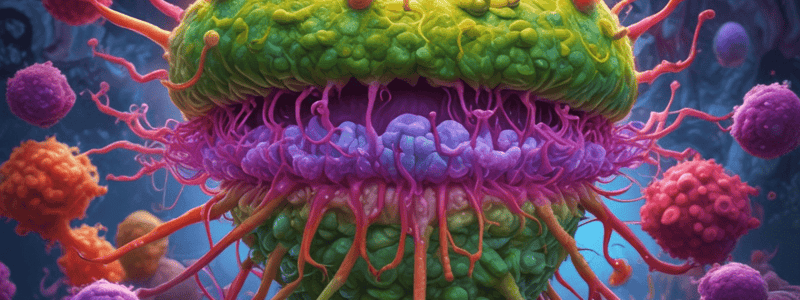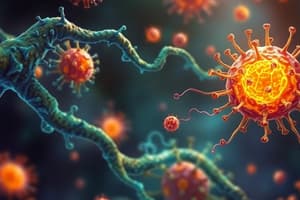Podcast
Questions and Answers
Which one of the following is a mechanism used by pathogens to evade phagocytosis?
Which one of the following is a mechanism used by pathogens to evade phagocytosis?
- Producing capsules that are too large to be engulfed by phagocytes (correct)
- Releasing cytokines to attract phagocytes
- Increasing the metabolic rate of the host
- Enhancing the immune response to increase antimicrobial substances
Which of the following is a consequence of fever?
Which of the following is a consequence of fever?
- Inhibition of the complement system
- Decreased immune response
- Induction of antimicrobial substances (correct)
- Decreased metabolic rate
What is the role of cytokines in the process of inflammation?
What is the role of cytokines in the process of inflammation?
- Cytokines inhibit the release of chemicals by leukocytes
- Cytokines promote chemotaxis of phagocytes to the site of tissue injury (correct)
- Cytokines reduce the accumulation of fluids at the site of inflammation
- Cytokines decrease the permeability of blood vessels
Which of the following is a characteristic of the complement system?
Which of the following is a characteristic of the complement system?
Which of the following is a mechanism used by pathogens to evade the immune system?
Which of the following is a mechanism used by pathogens to evade the immune system?
Which of the following is a symptom of inflammation?
Which of the following is a symptom of inflammation?
What is the role of the hypothalamus in the fever response?
What is the role of the hypothalamus in the fever response?
Which of the following is a function of the complement system?
Which of the following is a function of the complement system?
Which of the following is a step in the process of phagocytosis?
Which of the following is a step in the process of phagocytosis?
What is the key difference between innate immunity and adaptive immunity?
What is the key difference between innate immunity and adaptive immunity?
Which of the following is NOT a component of the innate immune system's first line of defense?
Which of the following is NOT a component of the innate immune system's first line of defense?
What is the primary function of the innate immune system's second line of defense?
What is the primary function of the innate immune system's second line of defense?
Which of the following is a key characteristic of the adaptive immune system?
Which of the following is a key characteristic of the adaptive immune system?
What is the primary difference between resistance and susceptibility in the context of host defenses?
What is the primary difference between resistance and susceptibility in the context of host defenses?
Which of the following is a key feature of the adaptive immune system's third line of defense?
Which of the following is a key feature of the adaptive immune system's third line of defense?
Which of the following statements best describes the relationship between host defenses and immunity?
Which of the following statements best describes the relationship between host defenses and immunity?
Which of the following is a key characteristic of the innate immune system's first line of defense?
Which of the following is a key characteristic of the innate immune system's first line of defense?
How do the innate and adaptive immune systems differ in their response time to pathogens?
How do the innate and adaptive immune systems differ in their response time to pathogens?
What is the mechanism of action by which normal microbiota defeat invading pathogenic bacteria?
What is the mechanism of action by which normal microbiota defeat invading pathogenic bacteria?
Which type of leukocytes is involved in allergic responses through releasing histamine?
Which type of leukocytes is involved in allergic responses through releasing histamine?
What is the term for the ingestion of microbes or other substances by a phagocyte?
What is the term for the ingestion of microbes or other substances by a phagocyte?
Where are monocytes found before maturing into macrophages?
Where are monocytes found before maturing into macrophages?
Which leukocytes are characterized by having granules in their cytoplasm that are visible with a light microscope?
Which leukocytes are characterized by having granules in their cytoplasm that are visible with a light microscope?
What is the primary role of eosinophils?
What is the primary role of eosinophils?
What is the primary function of the ciliary escalator in the respiratory tract?
What is the primary function of the ciliary escalator in the respiratory tract?
Which of the following is NOT a function of the skin as a physical barrier?
Which of the following is NOT a function of the skin as a physical barrier?
What is the primary role of blood transferrins in host defense?
What is the primary role of blood transferrins in host defense?
What is the primary mechanism by which the normal microbiota provides protection against pathogens?
What is the primary mechanism by which the normal microbiota provides protection against pathogens?
Which of the following is NOT a function of the lacrimal apparatus (tear production system) in host defense?
Which of the following is NOT a function of the lacrimal apparatus (tear production system) in host defense?
Which of the following is a chemical barrier in host defense?
Which of the following is a chemical barrier in host defense?
What is the primary function of gastric juices in host defense?
What is the primary function of gastric juices in host defense?
Which of the following statements about beneficial microbes is NOT true?
Which of the following statements about beneficial microbes is NOT true?
Which of the following is NOT a physical barrier in host defense?
Which of the following is NOT a physical barrier in host defense?
What is the primary role of opsonization in the complement system?
What is the primary role of opsonization in the complement system?
What is the primary outcome of inflammation mediated by the complement system?
What is the primary outcome of inflammation mediated by the complement system?
Which process describes the cytolytic action of the complement system?
Which process describes the cytolytic action of the complement system?
How do some pathogens evade the complement system through capsule production?
How do some pathogens evade the complement system through capsule production?
What is the mechanism by which interferons (IFNs) provide anti-viral defense in uninfected neighboring cells?
What is the mechanism by which interferons (IFNs) provide anti-viral defense in uninfected neighboring cells?
Which of the following is NOT a mechanism by which pathogens can evade the complement system?
Which of the following is NOT a mechanism by which pathogens can evade the complement system?
What is the primary function of interferons (IFNs) in the context of innate immunity?
What is the primary function of interferons (IFNs) in the context of innate immunity?
Which component of the innate immune system is responsible for the production of interferons (IFNs)?
Which component of the innate immune system is responsible for the production of interferons (IFNs)?
Which of the following statements about the innate immune system is correct?
Which of the following statements about the innate immune system is correct?
Flashcards are hidden until you start studying
Study Notes
Innate Immunity: Non-Specific Defenses of the Host
- Immunity: the ability to fight off pathogens and prevent disease
- Host defenses: the ability of the host to remove pathogens to prevent disease
- Innate immunity (non-specific host defenses): present at birth, no specific recognition of microbes, no immunological memory response, rapid immune response
- Adaptive immunity (specific host defenses): develops later, specific recognition and response to specific microbe, has immunological memory, slower immune response
1st Line of Host Defense: Physical Barriers
- Intact skin:
- Closely packed epithelial cells
- Continuous layering
- Keratin protein in top layer
- Dryness
- Shedding of top layer
- Mucous membranes and ciliary escalator:
- Epithelial layer that lines gastrointestinal, respiratory, and genitourinary tracts
- Secrete viscous fluid called mucus
- Cilia move together and sweep mucus up and out of the body
- Lacrimal apparatus and saliva, urine, and vaginal secretions:
- Protect the eyes
- Continuous washing action
- Flushing mechanism to wash away pathogens
1st Line of Host Defense: Chemical Barriers
- Chemical factors of the skin:
- pH of skin (slightly acidic)
- Salinity
- Sebum
- Lysozymes:
- Enzymes found in body secretions (sweat, tears, saliva)
- Break chemical bonds in peptidoglycan, destroying bacterial cell wall
- Gastric juices and blood transferrins:
- Gastric juices produced by stomach, containing enzymes and acid
- Blood transferrins: proteins that bind to iron, necessary for bacterial growth
1st Line of Host Defense: Biological Barriers
- Normal microbiota:
- Commensal microbes
- Beneficial microbes
- Competitive exclusion
Phagocytosis
- Phagocytosis: ingestion of microbes or other substances by a phagocyte
- Phagocyte: non-specific host cell capable of phagocytosis (e.g., neutrophils, macrophages, dendritic cells)
- Mechanism/phases of phagocytosis:
- Chemotaxis: release of chemical signals by pathogen attracts phagocytes
- Adherence: attachment of phagocyte to surface of pathogen
- Ingestion: endocytosis of pathogen, forming a phagosome that merges with a lysosome to form a phagolysosome
- Digestion: pathogen is digested inside a phagolysosome
Microbial Evasion of Phagocytosis
- Capsule production: making the pathogen too big to be engulfed
- Leukocidins: pore-forming toxin capable of killing phagocytes
- Mycolic acid: waxy lipid inhibiting lysosome enzymes of phagocyte
Inflammation
- Signs and symptoms:
- Pain due to release of certain chemicals by leukocytes
- Redness (erythema) due to increased blood flow
- Immobility due to local loss of function in severe inflammation
- Swelling (edema) due to accumulation of fluids
- Heat due to increased blood flow
- Process of inflammation:
- Tissue or cells get damaged
- Damaged cells release chemicals such as cytokines
- Cytokines promote chemotaxis of phagocytes
- Phagocytosis of invading pathogens begins
- Tissue gets repaired
Fever
- Toxins released by bacteria induce cytokine release from phagocytes
- Cytokines bind to hypothalamus receptors, increasing the set point for body temperature
- Person feels cold (chills) and increases their body temperature
- Once the new set point is reached, person experiences abnormally high body temperature (fever)
- As pathogens are eliminated, toxins and cytokines get eliminated, and body temperature falls, causing the decline of fever (crisis)
Consequences of Fever
- Increases metabolic rate
- Enhances immune response
- Induces antimicrobial substances
Studying That Suits You
Use AI to generate personalized quizzes and flashcards to suit your learning preferences.




